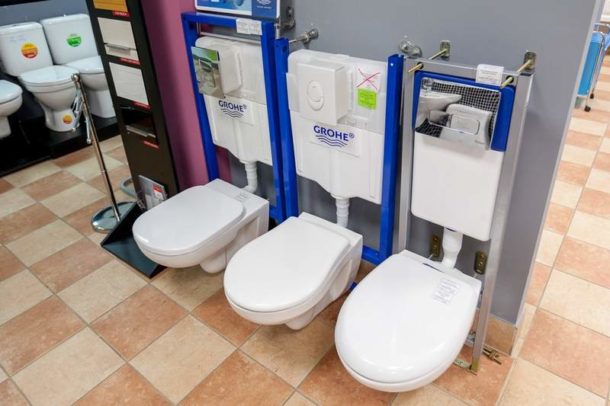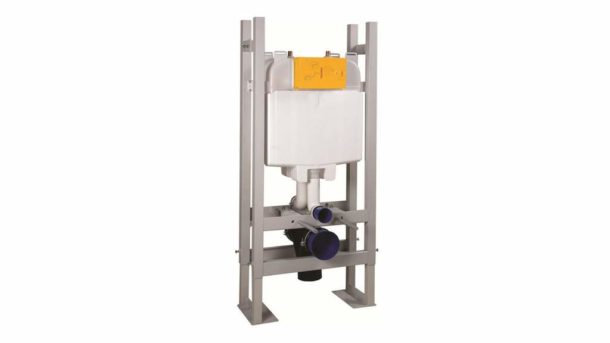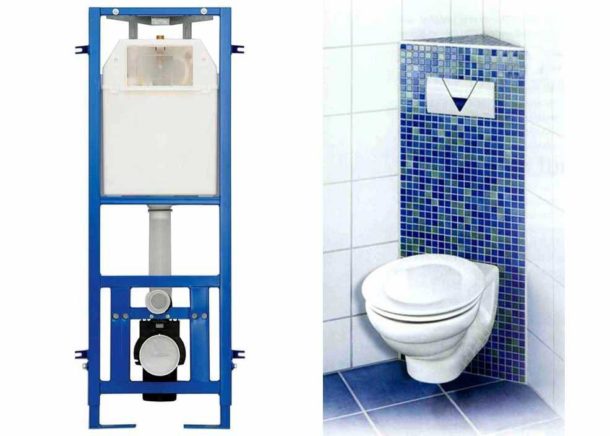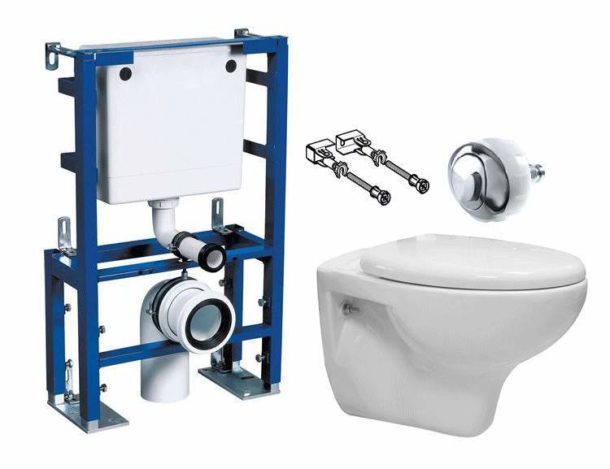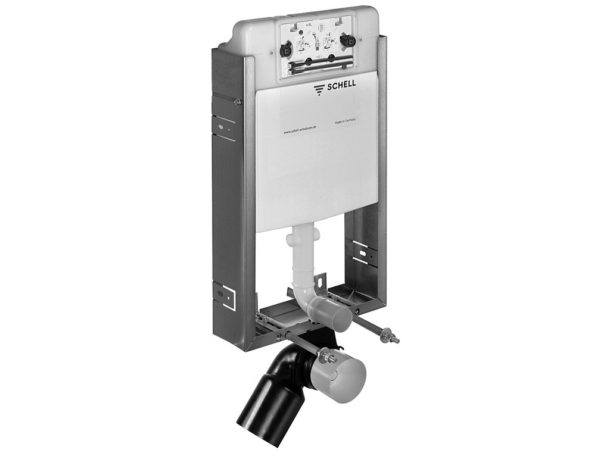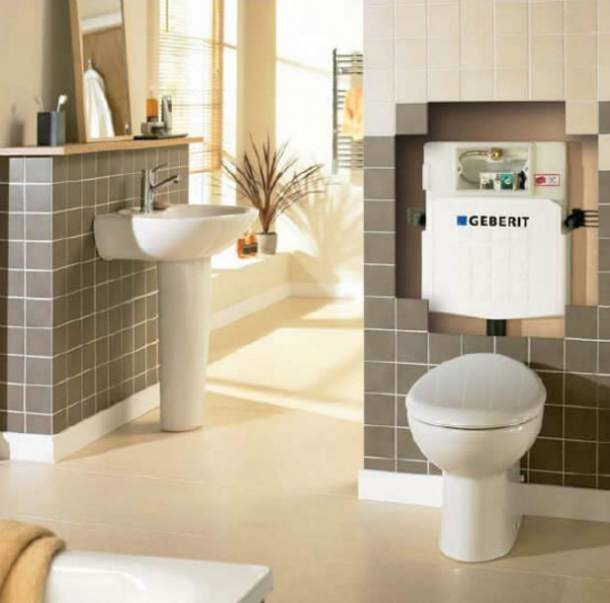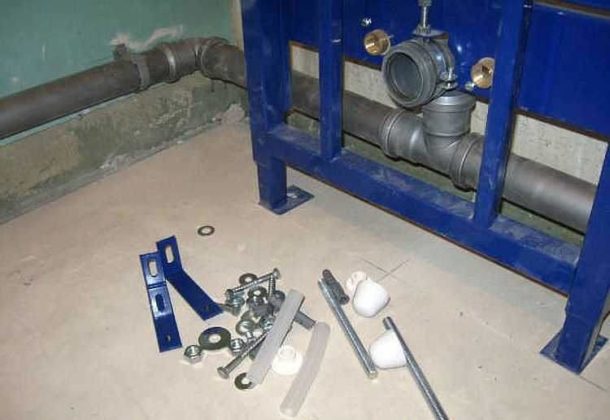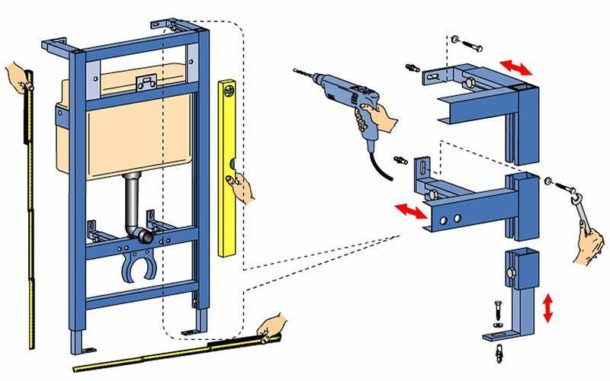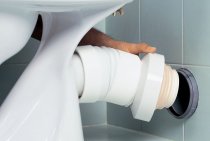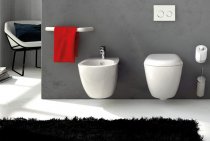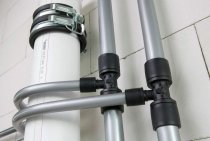Hanging toilets are a fairly new trend in bathroom design. They take up less space than conventional ones and allow you to hide all the drain fittings in the wall. But before installing them, it is necessary to carry out the installation of the installation - to fix all the elements of the system on the wall. This is easy to do on your own, you just need to choose the right place.
Types of installations
Manufacturers offer two types toilet installations:
- Block. This is a construction made of a plastic tank, to which drain fittings and fasteners are attached. This is the easiest and cheapest option. In this case, the toilet bowl can be both suspended and floor. This option is only suitable for mounting to a main wall.
- Frame. This is a metal frame that holds the bowl itself and the sewer pipes. At the same time, the wall practically does not bear any load, the structure only presses on the floor. This option is more reliable, as it can withstand weight up to 400 kg.
Most often, frame installations are installed. They do not require complex repairs, you do not need to break the walls of your apartment to get to communications.
How to choose the right place?
Remember that if you have chosen a block system, then it can only be installed in the main wall, so the choice of attachment points is immediately reduced.
The frame structure can be installed anywhere. Consider location options:
[smartcontrol_youtube_shortcode key="Select toilet installation systems" cnt="2" col="2" shls="true"]- Standard - near the wall, construction dimensions - 50 × 112 cm.
- Corner - A great option to save space, allowing you to install the toilet in the corner.
- Low - suitable for placing the system under a window.
- Double-sided - usually used in public places.
- Linear - combining a toilet bowl and a bidet into one design.
Before buying an installation, decide on its type and location in the toilet. The installation installation scheme should be ready before you go to the store.
Required materials for installation
For the correct installation of the toilet installation, you must prepare the following materials and tools:
- Level.
- Wrenches that fit the fasteners.
- Pencil.
- Perforator.
- Roulette.
- Installation with all fasteners.
If you need to drill a concrete wall, select drills that match the diameter of the fasteners.
Do not be too lazy to immediately prepare everything you need so as not to be distracted during the installation of the installation system for the toilet.
Installation of a block installation with a hanging toilet bowl
If you have chosen a more complex option, first study all the available instructions, including the installation of a do-it-yourself installation on the video.
[smartcontrol_youtube_shortcode key="mounting a wall hung toilet" cnt="2" col="2" shls="true"]Stages of work:
- First you need to mark the wall and floor in the place where the structure will be suspended. The axis of the toilet bowl should coincide with the axis of the room if it is small. In a large bathroom, when determining the position of the axis of the toilet, you need to focus on the axis of the sewer drain.
- The installation height of the system depends on its size. Usually it is about 1 meter from the floor. The width is usually indicated in the manufacturer's instructions, it may vary from company to company. Do not forget that the axis must run exactly in the center. Mark the fixing points on the wall.
- Drill holes and insert dowels. It is most reliable to hang the installation on dowel-nails, only they can withstand such a load.
- Screw on the sump.
- Remove the drain button, check if all gaskets are in place. For more information on how to do this, see the manufacturer's installation instructions.
- Connect pipes to tank.
- Drill holes for the bowl mounts. Usually it is hung so that the distance from the floor to the seat is 40–50 cm. Focus on your convenience when choosing an installation height.
- Insert toilet pins. It can be hung as a last resort.
- Fix the drain hose.
- Check the tightness of the system.
- If everything is in order, fix the wall with tiles or other finishing materials.
Installation of a block installation with a floor-standing toilet
This design allows you to hide the tank and communications, but at the same time reduces the load on the wall, because you do not need to hang the bowl. Installing a do-it-yourself toilet installation with a floor-standing toilet is much easier than the previous option.
Installation steps:
- It is necessary to mark the position of the drain tank on the wall. It is best to hang it so that the button is 1 meter from the floor.
- Holes are drilled in the wall, fasteners are installed and the tank is hung.
- The water pipe is connected.
- Mark the location of the toilet on the wall.
- Install a corrugation for draining.
- The wall is covered with finishing materials, a drain button is hung.
- Mount the toilet in place.
This option looks just as neat and minimalistic as the previous one, since all the pipes are hidden in the wall.
Installation of a frame installation with a hanging toilet bowl
This option is good because it allows you to put the toilet away from the walls, anywhere in the bathroom. After you choose a suitable place, you can start work.
Installing a toilet installation includes the following steps:
At the first stage, a metal frame with fasteners is assembled. Usually these frames are sold separately and fit different types of toilets. Next, the drain tank is installed on the frame. Its position can be adjusted with brackets. Please observe the following standard dimensions:
- The height from the floor to the drain button is 1 meter.
- The distance between the fasteners coincides with the distance between the bowl lugs.
- The height from the floor to the sewer pipe is 22 cm.
- The distance from the floor to the toilet seat is 40 cm.
Important! There should be at least one centimeter between the wall and the drain tank.
Now you need to attach the entire structure to the wall.
- Use the level to check the strict observance of verticals and horizontals. Mark the holes on the wall and floor, drill them and install the fasteners. Screw the frame securely to the floor and wall.
- After installing the frame, it is necessary to connect the water pipe. It is best to opt for a plastic pipe than a flexible hose. The latter will not last as long as the toilet. And changing the hoses hidden in the wall is problematic, so plastic pipes are most often used - they can be connected to the tank from above or from the side. Connect the drain corrugation to the sewer and check the installed system for leaks.
- Install the pins on which you then need to hang the toilet. Assemble a frame of metal profiles for the wall that will close the installation.
- Take moisture-resistant drywall with a thickness of at least 1 cm, cut it to the size of the false wall. Attach to metal profiles. Don't forget to make holes for drains and buttons. From above, you can make a tiled pattern.
Toilet installation it is best to carry out 1.5-2 weeks after the end of work.
A frame installation for a hanging toilet is more expensive and more difficult to install than a block one, but it leaves a lot of room for creativity.
Mounting errors
If you have never worked with plumbing, then installing an installation under the toilet with your own hands can cause you difficulties. Fortunately, all the wizard's mistakes can be easily corrected.
Issues you may encounter:
- Drain tank leaking. Check that the gaskets are installed correctly. Turn off the water, unscrew the fasteners and adjust the seals if necessary.
- The floor toilet is leaking. It is necessary to cover the joints with the corrugation under the toilet with silicone.
- Water stagnates in the bowl. Check the angle of the drain corrugation. It should be equal to 45 degrees.
- The toilet is swinging. Tighten all fasteners. The same should be done with a swinging tank.
You can see a photo of the correct installation on the website.
If you are renovating a bathroom and don't know how to install the installation, follow our advice, then you will succeed. Installing a modern toilet installation is not a very complicated process. But if you have never done plumbing work, it may be worth entrusting it to professionals. A properly installed system will delight you for many years.
